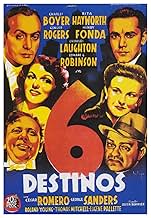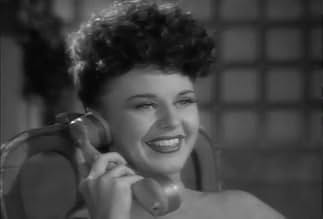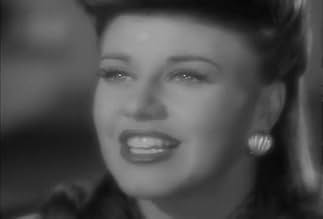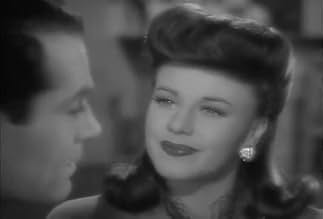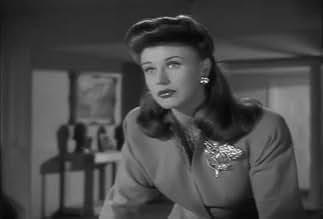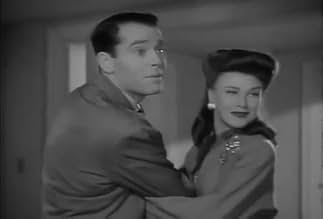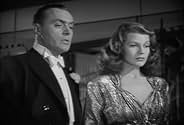IMDb RATING
7.3/10
2.7K
YOUR RATING
A formal tailcoat that gets passed from one owner to another affects each life in a significant way.A formal tailcoat that gets passed from one owner to another affects each life in a significant way.A formal tailcoat that gets passed from one owner to another affects each life in a significant way.
- Awards
- 7 wins total
Featured reviews
This movie is made up of many vignettes featuring many capable stars--all centering on the same second-hand tuxedo as it is passed on from one owner to the next. I won't try to elaborate on all the segments, as one of the previous reviewers did a very thorough job of describing them. However, they are all extremely well-crafted and engaging. I would also agree that stylistically, this film is reminiscent of IF I HAD A MILLION, though the stories in Tales of Manhattan are generally less funny but more polished.
The one portion of the movie that really stood out for me was the one featuring the down-and-out Edward G. Robinson attending his college class reunion (from Harvard, I think). He goes in a tattered old hand-me-down tux hoping to fool his old chums into thinking he's made it in life. You really feel for the guy in his plight--especially when a mean-spirited member of the class seeks to expose the ruse! So give it a try, why don't ya?
The one portion of the movie that really stood out for me was the one featuring the down-and-out Edward G. Robinson attending his college class reunion (from Harvard, I think). He goes in a tattered old hand-me-down tux hoping to fool his old chums into thinking he's made it in life. You really feel for the guy in his plight--especially when a mean-spirited member of the class seeks to expose the ruse! So give it a try, why don't ya?
This is a clever frame story that follows the "experiences" of a formal tails jacket from the upper crust of the idle rich down through all levels of society. The all-star cast give great performances in five well-written stories.
The film's theme has to do with the American Dream and what it really means. To some it is just social pretense and money. But to others, it is the right to express one's own art, to retain one's dignity, and to live free from fear of poverty.
This is a charming and moving film. Don't pass it up.
The film's theme has to do with the American Dream and what it really means. To some it is just social pretense and money. But to others, it is the right to express one's own art, to retain one's dignity, and to live free from fear of poverty.
This is a charming and moving film. Don't pass it up.
The movements of an accursed tail coat about the Big City, and the lives of those who use it, becomes part of the TALES OF MANHATTAN.
Fox Studios and director Julien Duvivier fashioned this most enjoyable film. The idea of the tail coat never becomes silly or gets in the way of the plot, which doles out equal amounts of irony, suspense, pathos & comedy. The all-star cast gives worthy performances which keeps the viewer's attention right to the very end.
SEQUENCE ONE An actor and his lover (Charles Boyer & Rita Hayworth) are confronted by her quietly sadistic husband (Thomas Mitchell). Eugene Palette plays Boyer's loyal valet. An unbilled Robert Greig appears as the corpulent creator of the elegant tail coat.
Most of the action in this sequence takes place at an estate outside of Manhattan.
SEQUENCE TWO A shy fellow (Henry Fonda) tries to help his friend (Cesar Romero) out of a jam with his suspicious fiancé (Ginger Rogers). Gail Patrick appears as Rogers' nosy gal pal; Roland Young plays Romero's protective valet.
A quite different tail coat is the center of the plot here, which can become a bit confusing.
SEQUENCE THREE A poor composer (Charles Laughton) finally has the opportunity to conduct his magnum opus at a concert. Radiant Elsa Lanchester appears as Laughton's adoring wife. Christian Rub plays a friendly cellist, while Victor Francen is very believable as the noble Bellini. An unbilled Dewey Robinson plays the bullying owner of a small café.
Laughton is magnificent, as is to be expected, giving another master class in how to turn a small part into something very special.
SEQUENCE FOUR
After being spiffed-up and accoutered in the tail coat, a skid row bum (Edward G. Robinson) makes a poignant appearance at the Waldorf-Astoria for his college's 25-year class reunion. James Gleason plays the kindly parson who runs a rescue mission; silent screen star Mae Marsh appears as his sweet-natured wife. Harry Davenport appears as a wise old professor; George Sanders snarls his way through his role as Robinson's old antagonist.
Robinson & Gleason do some impressive acting, making their characters come alive.
SEQUENCE FIVE
An eccentric professor (W.C. Fields) gives a temperance lecture to a gathering of high society swells, not knowing that the coconut milk has been liberally spiked. Phil Silvers shines in the brief role of the secondhand dealer who sells the tail coat to Fields. The monumental Margaret Dumont enlivens her scant appearance as the matron sponsoring Fields.
Before the film's initial release, there was consternation from some of the other major stars concerning Fields' large salary. The clamor grew to the point that Fox weaseled out by simply excising the sequence entirely. Rumor was allowed to grow that the removal was due to an inept performance from Fields. This is tragic, in that it was to be one of Fields' final appearances on film and he is hilarious, as is Phil Silvers (who has the distinction of being practically the only person in film history who ever managed to both outtalk & hoodwink Fields). After more than half a century, this sequence has finally been reunited with the rest of the film--the only problem, for anyone that cares, being a slight one of continuity, as it is not shown how the tail coat returns to the Santelli Bros. shop in time for the burglary that opens Sequence Six.
You have to be quick to read the painted sign on the Santelli Bros. window: WE TAKE AN ABSOLUTE LOSS ON EVERY TRANSACTION WE'RE ECCENTRIC
SEQUENCE SIX
In the film's most photographically stylish sequence, a shanty town full of impoverished farmers rejoice when the tail coat--and its pocket full of cash--literally falls out of the sky. J. Carrol Naish plays the airborne robber who loses the coat. Paul Robeson & Ethel Waters are the couple who find it. Eddie 'Rochester' Anderson is their gently conniving preacher; an almost unrecognizable Clarence Muse appears as a greedy old grandfather. Members of the wonderful Hall Johnson Choir lift their voices as the jubilant townsfolk.
Once again, the action in this sequence mostly occurs far from Manhattan. The short song at the very end is the only occasion Robeson and The Hall Johnson Choir ever sang together on film--and, unbelievably, Miss Waters isn't allowed to sing at all.
********************
Director Duvivier and stars Boyer, Robinson & Mitchell would travel to Universal Studios to make another sequential film, FLESH AND FANTASY, in 1943.
Fox Studios and director Julien Duvivier fashioned this most enjoyable film. The idea of the tail coat never becomes silly or gets in the way of the plot, which doles out equal amounts of irony, suspense, pathos & comedy. The all-star cast gives worthy performances which keeps the viewer's attention right to the very end.
SEQUENCE ONE An actor and his lover (Charles Boyer & Rita Hayworth) are confronted by her quietly sadistic husband (Thomas Mitchell). Eugene Palette plays Boyer's loyal valet. An unbilled Robert Greig appears as the corpulent creator of the elegant tail coat.
Most of the action in this sequence takes place at an estate outside of Manhattan.
SEQUENCE TWO A shy fellow (Henry Fonda) tries to help his friend (Cesar Romero) out of a jam with his suspicious fiancé (Ginger Rogers). Gail Patrick appears as Rogers' nosy gal pal; Roland Young plays Romero's protective valet.
A quite different tail coat is the center of the plot here, which can become a bit confusing.
SEQUENCE THREE A poor composer (Charles Laughton) finally has the opportunity to conduct his magnum opus at a concert. Radiant Elsa Lanchester appears as Laughton's adoring wife. Christian Rub plays a friendly cellist, while Victor Francen is very believable as the noble Bellini. An unbilled Dewey Robinson plays the bullying owner of a small café.
Laughton is magnificent, as is to be expected, giving another master class in how to turn a small part into something very special.
SEQUENCE FOUR
After being spiffed-up and accoutered in the tail coat, a skid row bum (Edward G. Robinson) makes a poignant appearance at the Waldorf-Astoria for his college's 25-year class reunion. James Gleason plays the kindly parson who runs a rescue mission; silent screen star Mae Marsh appears as his sweet-natured wife. Harry Davenport appears as a wise old professor; George Sanders snarls his way through his role as Robinson's old antagonist.
Robinson & Gleason do some impressive acting, making their characters come alive.
SEQUENCE FIVE
An eccentric professor (W.C. Fields) gives a temperance lecture to a gathering of high society swells, not knowing that the coconut milk has been liberally spiked. Phil Silvers shines in the brief role of the secondhand dealer who sells the tail coat to Fields. The monumental Margaret Dumont enlivens her scant appearance as the matron sponsoring Fields.
Before the film's initial release, there was consternation from some of the other major stars concerning Fields' large salary. The clamor grew to the point that Fox weaseled out by simply excising the sequence entirely. Rumor was allowed to grow that the removal was due to an inept performance from Fields. This is tragic, in that it was to be one of Fields' final appearances on film and he is hilarious, as is Phil Silvers (who has the distinction of being practically the only person in film history who ever managed to both outtalk & hoodwink Fields). After more than half a century, this sequence has finally been reunited with the rest of the film--the only problem, for anyone that cares, being a slight one of continuity, as it is not shown how the tail coat returns to the Santelli Bros. shop in time for the burglary that opens Sequence Six.
You have to be quick to read the painted sign on the Santelli Bros. window: WE TAKE AN ABSOLUTE LOSS ON EVERY TRANSACTION WE'RE ECCENTRIC
SEQUENCE SIX
In the film's most photographically stylish sequence, a shanty town full of impoverished farmers rejoice when the tail coat--and its pocket full of cash--literally falls out of the sky. J. Carrol Naish plays the airborne robber who loses the coat. Paul Robeson & Ethel Waters are the couple who find it. Eddie 'Rochester' Anderson is their gently conniving preacher; an almost unrecognizable Clarence Muse appears as a greedy old grandfather. Members of the wonderful Hall Johnson Choir lift their voices as the jubilant townsfolk.
Once again, the action in this sequence mostly occurs far from Manhattan. The short song at the very end is the only occasion Robeson and The Hall Johnson Choir ever sang together on film--and, unbelievably, Miss Waters isn't allowed to sing at all.
********************
Director Duvivier and stars Boyer, Robinson & Mitchell would travel to Universal Studios to make another sequential film, FLESH AND FANTASY, in 1943.
This is a forgotten classic. It's funny, moving and old fashioned. Add the fact that it's chock full of stars and you have one fun movie to watch. Edward G. Robinson is a standout as a bum trying to make good. If you like old movies, try to hunt this one down.
This film's cast is so amazing you're going to expect it to be a perfect 10. You will most likely love some vignettes and only like others. You will be glad you watched and will be entertained.
Did you know
- TriviaW.C. Fields appeared in a chapter which was cut from the final theatrical version. It had been restored to the 1996 VHS version. Also in the segment are Margaret Dumont Marcel Dalio, and Phil Silvers. However, when it was later on released in DVD, the Fields segment was deleted again.
- GoofsEven though the audience has seen a close-up of Charles Boyer's bullet wound behind the left side of his jacket, when he turns to say goodbye to Mitchell and Hayworth the left side of the jacket lifts, and there is no bloodstain.
- Quotes
Paul Orman: What did you want to say about guns, Mr. Halloway?
John Halloway: Ever use 'em?
Paul Orman: Yes, on the stage.
Paul Orman: Shoot 'em?
John Halloway: On the stage.
John Halloway: Not real bullets?
Paul Orman: No.
John Halloway: Just blanks, eh?
Paul Orman: Yes, only blanks. We actors prefer them.
- Crazy creditsThe following contains a restored sequence starring W.C. Fields which was not included in the original theatrical release of "Tales of Manhattan."
- Alternate versionsSome scenes featuring W.C. Fields were filmed but cut from the movie before release. The US video version restores this unseen footage. In this 9 minute sequence, Phil Silvers and Marcel Dalio played the Santelli Brothers who owned the used clothing store where Fields bought the dinner jacket. Margaret Dumont played a wealthy woman who hired Fields to give a lecture on the evils of alcohol. The J. Carroll Naish episode was filmed and substituted for the longer Fields episode after it was cut.
- ConnectionsFeatured in M.A.S.H.: Morale Victory (1980)
- SoundtracksPerpetual Motion (Perpetuum mobile, Op. 257)
(uncredited)
Music by Johann Strauss
Played at the concert hall rehearsal
- How long is Tales of Manhattan?Powered by Alexa
Details
- Release date
- Country of origin
- Official sites
- Language
- Also known as
- Tales of Manhattan
- Filming locations
- Production company
- See more company credits at IMDbPro
Box office
- Budget
- $1,000,000 (estimated)
- Runtime
- 1h 58m(118 min)
- Color
- Aspect ratio
- 1.37 : 1
Contribute to this page
Suggest an edit or add missing content

